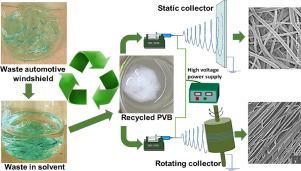Journal of the Taiwan Institute of Chemical Engineers ( IF 5.5 ) Pub Date : 2021-11-12 , DOI: 10.1016/j.jtice.2021.11.003 Burcu Guner 1 , Y. Emre Bulbul 1, 2 , Nursel Dilsiz 3

|
Background
The increasing costs of polymer materials and the environmental pollution caused by their waste make the use of recycled materials increasingly important. Waste polyvinyl(butyral) (PVB-W) recycled from end-of-life vehicle windshields has attracted intensive attention as a usable and abundant resource. However, large amounts of PVB-W are still buried in landfills due to the lack of recycling techniques and difficulty in achieving uniform control over the properties of the recycled polymer.
Methods
As an opportunity, this work reports the recycling of PVB by chemical and the fabrication of its electrospun nanofibers, which can be used in various applications such as textile, coating, filtration, and adsorption. In this regard, the electrospun nanofibers were fabricated from both recycled and commercial PVB in random or aligned morphology using the static or rotating collector. The electrospun nanofibers were characterized through various techniques. (i.e. infrared spectroscopy, nuclear magnetic resonance spectroscopy, X-ray diffraction, Differential scanning calorimetry, scanning electron microscope, atomic force microscope, and nanoindentation).
Findings
The results showed that recycled PVB nanofibers and commercial PVB (C-PVB) nanofibers have similar physicochemical and morphological features, and recycled PVB nanofibers are of the same quality as commercial PVB nanofibers, which can serve the industry in many fields. This research can initiate an innovative path to PVB-W based fibrous materials with desired properties, which will widen the reuse of PVB-W.
中文翻译:

从废旧汽车挡风玻璃中回收聚乙烯醇缩丁醛及其电纺纤维材料的制造
背景
高分子材料成本的不断上涨及其废弃物造成的环境污染,使得再生材料的使用变得越来越重要。从报废汽车挡风玻璃回收的废聚乙烯醇(丁醛)(PVB-W)作为一种可用且丰富的资源引起了广泛关注。然而,由于缺乏回收技术和难以实现对回收聚合物性能的统一控制,大量的 PVB-W 仍被掩埋在垃圾填埋场中。
方法
作为一个机会,这项工作报告了通过化学回收 PVB 及其电纺纳米纤维的制造,可用于纺织、涂层、过滤和吸附等各种应用。在这方面,静电纺丝纳米纤维是使用静态或旋转收集器由回收的和商业的 PVB 制成的,具有随机或排列的形态。电纺纳米纤维通过各种技术进行了表征。(即红外光谱、核磁共振光谱、X射线衍射、差示扫描量热法、扫描电子显微镜、原子力显微镜和纳米压痕)。
发现
结果表明,再生PVB纳米纤维与商用PVB(C-PVB)纳米纤维具有相似的物理化学和形态特征,且再生PVB纳米纤维与商用PVB纳米纤维质量相同,可在多个领域服务于工业。这项研究可以开辟一条具有所需性能的基于 PVB-W 的纤维材料的创新途径,这将扩大 PVB-W 的再利用。











































 京公网安备 11010802027423号
京公网安备 11010802027423号